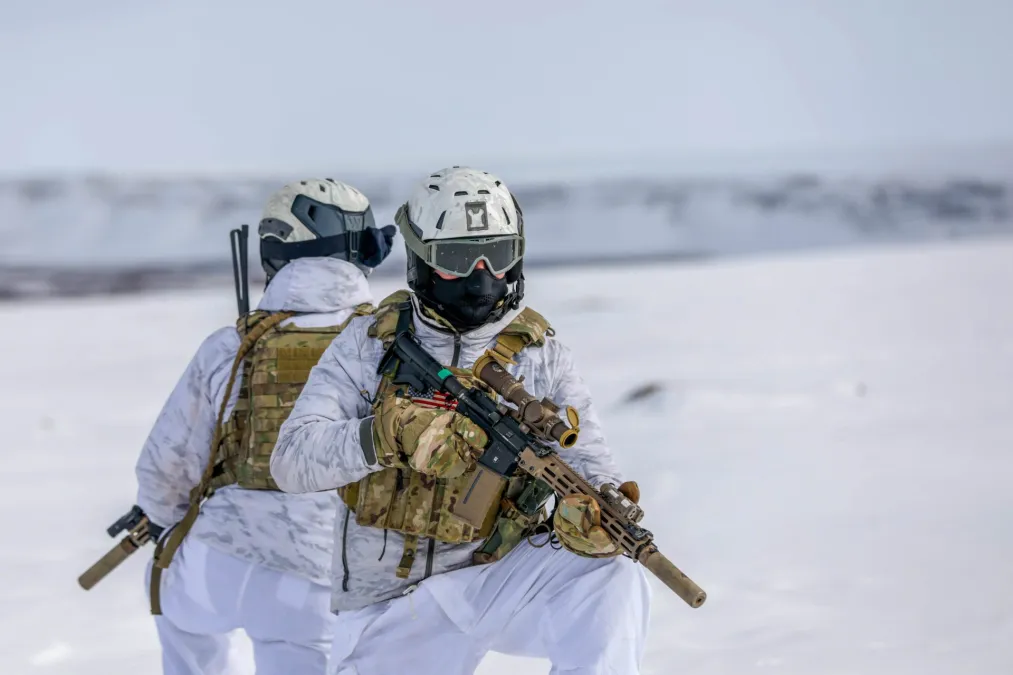Arctic strategy implementation plan calls for enhanced military comms, sensing and PNT

The White House on Monday published the implementation plan for its 10-year Arctic strategy, including new directives for the Defense Department to bolster security and deter adversary activity in the region.
The document follows the publication of the Biden-Harris administration’s strategy, released in 2022, that outlined four pillars related to emerging issues in the Arctic — one of which called on the Pentagon to develop capabilities for enhanced military operations. The other three focused on the long-term impacts of climate change, economic development and international partnerships.
The plan now lists broad strategic security-related objectives — improving understanding of the Arctic operating environment, increasing presence in the region and working with relevant allies and partners — that also includes specific actions for the Defense Department and other federal agencies to take to deter aggression in the region.
“Our security in the Arctic is inclusive of many interests, from national defense and homeland security to safe commercial and scientific activities. However, the Arctic environment poses region-specific challenges that require tailored technology, assets, infrastructure, training, and planning,” the implementation plan states. “To secure our interests as attention, investments, and activity grow in the Arctic over the coming decades, the United States will enhance and exercise both our military and civilian capabilities in the Arctic as required to deter threats and to anticipate, prevent, and respond to both natural and human-made incidents.”
The original strategy pointed to both Russia’s increased military posture and China’s plans to grow its influence in the region as areas of concern for national security. In order to keep tabs on adversaries and track potential threats, the new plan calls for improvements to domain awareness capabilities. That includes making investments to replace and upgrade outdated systems and infrastructure, expand coverage of the Arctic and incorporate emerging technologies.
The Pentagon will partner with Arctic nations to conduct research and development tailored for operations in the region — specifically with Canada to “modernize, improve and better integrate” capabilities for the North American Aerospace Defense Command (NORAD), per the document.
Having persistent and accurate eyes in far northern latitudes is a top priority for leaders at NORAD. And the joint U.S.-Canadian organization is seeking capabilities — from long-range radars to artificial intelligence — that will offer better domain awareness.
The White House also directed the Defense Department to put funds towards updating current and developing new real-time observation, modeling and data analytic capabilities for the region.
Much of the directives for the Pentagon are focused on capabilities that are used to monitor the weather — including investments across the next five-to-seven years for the Navy’s Oceanographic and Atmospheric Master Library’s Ambient Noise Database and a Space Force-led effort to develop a real-time model of the ionosphere “to monitor and provide data on environmental conditions unique to the Arctic region and thus afford opportunities to predict and potentially mitigate the effects of changes in the natural environment.”
In addition, the implementation plan calls on both the Pentagon and NASA to “improve communications and positioning, navigation, and timing (PNT) capabilities by developing communications and data networks capable of operating in the northern latitudes.”
Satellite communications and GPS availability in the Arctic are extremely limited for the U.S. military, as the connecting data links become unstable due to long distances needed to operate in the environment. A number of services are exploring new ways to offer more reliable capabilities for the region, such as low-Earth orbit (LEO) constellations.
NASA is tasked with evaluating existing and emerging U.S. commercial space-based assets — particularly LEO satcom constellations — in order to “assess their sufficiency to fulfill the identified requirements and user needs” by mid-fiscal 2024, according to the implementation plan. The agency will also create a framework dedicated to potential partnerships related to future satcom needs in the Arctic by the end of fiscal 2024, it noted.
On the other hand, the Defense Department will assess the availability of the global positioning system in the region — both as a stand-alone capability and in combination with similar allied space-based capabilities like Europe’s Galileo and Japan’s Quasi-Zenith — among other directives to enhance Arctic-based situational awareness and communications, according to the document.
Along with improved capabilities, the Arctic strategy implementation plan seeks to deter potential hostile activity with enhanced force posture and Arctic-focused military exercises.
“The United States will maintain and, as driven by requirements, refine and advance our military presence in the Arctic in support of our homeland defense, global military and power projection, and deterrence goals,” the document states. “We will make targeted investments to strategically enhance security infrastructure as required to enable these aims, while building the resilience of critical infrastructure to protect against both climate change and cyberattacks.”
The White House is directing the Pentagon to leverage region-specific military exercises, like Arctic Edge and Arctic Challenge, that are conducted with allies and partners “to develop and strengthen homeland defense plans in the Arctic and exercise Joint presence,” in addition to other training for cold-weather and Arctic operations.
Finally, the Pentagon is charged with coordinating with allies and partners in the Arctic to not only understand the region but also improve overall deterrence and readiness. The implementation plan directs enhanced partnerships with Canada, Arctic NATO nations, Alaska and Alaska Native and rural communities for a range of activities — including combined exercises, training on cold-weather ops and overall interoperability.






